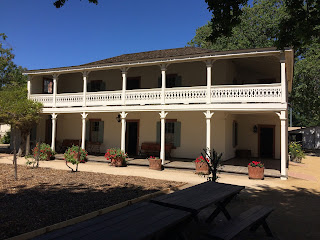There isn't really a musical about Frenchtown (unless I decide to write more...) - this just came to me.
(The curtain opens on a stage split between two different locations and two different years.
Stage Right, a marquee reads "Exposition Park, 1870". The scene is a bedroom in the Lachenais house. A Spanish guitar sits on the narrow single bed.
Stage Left, a marquee reads "Calabasas, 1880". The scene is the parlor in the grand Leonis adobe, complete with a piano. The window is wide open.
Serafina Lachenais enters, stage right. She sits on the bed and picks up the guitar.
Marcelina Leonis enters, stage left. She sits at the piano.
Both girls begin to play their instruments.)
Song: "My Daddy is a Monster"
Serafina: They say my daddy is a monster
I know that they are right
When I was eight he killed a man
And ran off into the night
Marcelina: They say my daddy is a monster
I know it must be true
He's greedy and self-serving
And trigger-happy too
Serafina: Some say I was lucky to be adopted
But this is rotten luck
My mom is dead, my dad's a psycho
And I feel so stuck
Marcelina: He hates my big half-brother
Won't let him in the house
Scares everyone who works for him
And gets judge and jury soused
Serafina: Wicked
Marcelina: Brutal
Serafina: Evil
Marcelina: Cruel
Serafina: Scary
Marcelina: Vicious
Serafina: Rotten
Marcelina: Malicious
Serafina: Mom was scared of Dad
Their relationship was grim
Everybody thinks he killed her
And I wouldn't put it past him
Marcelina: Daddy only loves three things
Money, booze, and me
He treats my mother like the help
And only married her for money
Serafina: Murdered Mr. Deleval
Blinded someone with a gunshot
Beat that Tongva man to death
(Spoken) Unfortunately, Daddy's all I've got
Marcelina: Daddy rules the western Valley
Fear's the biggest reason
No matter what the calendar says
(Spoken) In Calabasas, murder is in season
Serafina: Life is tough
Marcelina: It's quite restricting
Serafina: I feel so torn
Marcelina: It's so conflicting
Serafina and Marcelina (together): When your daddy is a monster.
Voice (offstage): Serafina! Serafina, come quickly! Your father's been arrested!
Serafina: Again?! What's he done now?
Voice: He shot the man next door!
Serafina (crying softly, defeated): Daddy. No.
(Serafina exits, stage right. Juan Menendez appears, stage left, and is visible through the open parlor window.)
Juan (through window): Hey, little sister. Are you feeling any better?
Marcelina: Hey, big brother. This headache just won't go away. And now my back hurts.
Juan: You're sweating.
Marcelina: That's odd. I'm freezing.
(Miguel Leonis enters, stage left, behind Juan. He is visible through the parlor window.)
Miguel: How many times do I have to tell you to stay off the damn porch?! (Threatens Juan with a revolver.)
Marcelina: Daddy, no! (Jumps to her feet, gets woozy, and collapses.)
(Curtain falls.)
Serafina Lachenais enters, stage right. She sits on the bed and picks up the guitar.
Marcelina Leonis enters, stage left. She sits at the piano.
Both girls begin to play their instruments.)
Song: "My Daddy is a Monster"
Serafina: They say my daddy is a monster
I know that they are right
When I was eight he killed a man
And ran off into the night
Marcelina: They say my daddy is a monster
I know it must be true
He's greedy and self-serving
And trigger-happy too
Serafina: Some say I was lucky to be adopted
But this is rotten luck
My mom is dead, my dad's a psycho
And I feel so stuck
Marcelina: He hates my big half-brother
Won't let him in the house
Scares everyone who works for him
And gets judge and jury soused
Serafina: Wicked
Marcelina: Brutal
Serafina: Evil
Marcelina: Cruel
Serafina: Scary
Marcelina: Vicious
Serafina: Rotten
Marcelina: Malicious
Serafina: Mom was scared of Dad
Their relationship was grim
Everybody thinks he killed her
And I wouldn't put it past him
Marcelina: Daddy only loves three things
Money, booze, and me
He treats my mother like the help
And only married her for money
Serafina: Murdered Mr. Deleval
Blinded someone with a gunshot
Beat that Tongva man to death
(Spoken) Unfortunately, Daddy's all I've got
Marcelina: Daddy rules the western Valley
Fear's the biggest reason
No matter what the calendar says
(Spoken) In Calabasas, murder is in season
Serafina: Life is tough
Marcelina: It's quite restricting
Serafina: I feel so torn
Marcelina: It's so conflicting
Serafina and Marcelina (together): When your daddy is a monster.
Voice (offstage): Serafina! Serafina, come quickly! Your father's been arrested!
Serafina: Again?! What's he done now?
Voice: He shot the man next door!
Serafina (crying softly, defeated): Daddy. No.
(Serafina exits, stage right. Juan Menendez appears, stage left, and is visible through the open parlor window.)
Juan (through window): Hey, little sister. Are you feeling any better?
Marcelina: Hey, big brother. This headache just won't go away. And now my back hurts.
Juan: You're sweating.
Marcelina: That's odd. I'm freezing.
(Miguel Leonis enters, stage left, behind Juan. He is visible through the parlor window.)
Miguel: How many times do I have to tell you to stay off the damn porch?! (Threatens Juan with a revolver.)
Marcelina: Daddy, no! (Jumps to her feet, gets woozy, and collapses.)
(Curtain falls.)




























